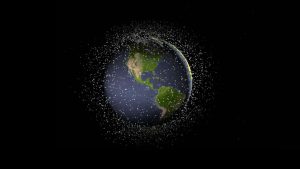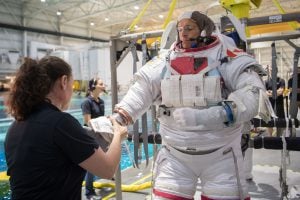
Environment
Earth’s orbit has become a cosmic landfill
Michel Doyon, manager of flight and systems operations at the Canadian Space Agency, walks us through what space debris is and its impact on Canada
- 1676 words
- 7 minutes
Travel
Perched on a ridge overlooking the Beagle Channel on the southern edge of Tierra del Fuego, this Argentinian hotel brings you close to nature—and its bounty. (King crab, anyone?)

Even after I step into the lobby of the Arakur and leave behind the grassy hummocks cushioning the mountain outside, it’s impossible not to feel like I’m still buffered by nature. Smooth lenga wood floors extend a friendly reception, while the life-size tapestry behind the check-in counter is more like a warm, cozy hug. Although most guests (me included) don’t realize it at first, this woollen embrace represents an initial meeting with the strait that connects the Atlantic and Pacific oceans. What I’m looking at is the Beagle Channel — beautifully rendered in felt.
I’ve arrived in Ushuaia, at the southern tip of Argentina, a couple of days ahead of a trip to the Antarctic Peninsula. The city, I discover, is more hectic than I had expected for a place that doesn’t hesitate to call itself “the end of the world.” It’s been like that since cruise-ship traffic to Antarctica started booming two decades ago. Good thing, then, that I booked a room at the Arakur, a 20-minute drive out of the city, up a mountain and into a nature reserve.
To ease myself into the unanticipated busyness of this Patagonian outpost, I spend my first day at the hotel. I quickly lay claim to a comfy leather chair by the floor-to-ceiling windows in the lounge, where I drink espressos, nibble crab empanadas and read about the Southern Ocean. The panoramic view lets me rest my eyes on the Beagle Channel — the real one flanked by rocky shores, one in Argentina, the other in Chile. Around lunchtime, the background soundtrack of murmuring voices and heels on hardwood is overwhelmed by the lively notes from a piano. It turns out that in addition to daytime live music, the property puts on bigger acts on some evenings and also hosts art exhibits highlighting regional talent, not to mention wine tastings in the on-site cellar. And if you don’t feel like going into town for dinner, sit down at La Cravia for everything from hake ceviche to king-crab ravioli to grilled lamb, washed down with crisp albariño or robust malbec.
Easing it in doesn’t mean you have to stay put. I, for one, alternate between Arakur’s great indoors and the hiking trails in the nature reserve that surrounds the property. The Reserva Natural Cerro Alarkén, at some 100 hectares, is a microcosm of the southern Patagonian flora and fauna. Lichen-draped southern beech, chartreuse mosses, spiky calafate-berry bushes and bright orange Darwin’s fungus flank trails that tunnel through forest before widening in grassy meadows. If you’re lucky (I was), you might spot the large Magellanic woodpecker, and if you’re extra lucky (I wasn’t), the South American grey fox.
The hike in the woods, paired with the cool wind and drizzle, are good reasons (if you need any) to sink into the pools and hot tubs at the spa. I linger in the heated outdoor infinity pool, taking in the port and the nearby snow-capped mountain. I dunk my head and hear whale song emanating from underwater speakers; high above, caracaras are doing aerobatics. Even right here, in this tiny spot amid the vastness of Patagonia, the ocean and mountains have a way of meeting, of merging the elements that make up the drama of Tierra del Fuego. I may be, as the locals put it, at the end of the world. But frankly, that’s not the end of the world.

Of course, you can’t visit the end of the world without exploring the end of the world, so here are a few navigation points I’m glad I did not miss. You can reach these Ushuaia spots easily thanks to the Arakur’s free shuttle; for excursions farther afield, talk to the hotel reception staff for information and help with booking.
In a place that boasts of being the end of the world, it’s no surprise that the Land of Fire is also home to the planet’s southernmost national park. Parque Nacional Tierra del Fuego feels magical, maybe because the vegetation, dominated by native southern beech, smells and sounds different from a northern forest. The winds hurled up the mountains from Cape Horn whip up cloud formations that seem bolder than they do at home, or perhaps that’s the mind having been convinced this is the end of the world. Spend a day hiking — or a few days, if you rent camping gear — and make time for a stop at Alakush visitors centre to hear about the culture of the Indigenous Yagán (also called Yámana), Selk’nam and Tehuelche peoples.
On the 12-kilometre drive to and from the park, you might spot the End of the World Train chugging alongside a section of the road. And yes, the train, which in the past was used to transport prisoners from the jail to work camps in the forest, is now a tour opportunity, giving you a more relaxed way to see some of the park’s wetlands, rivers and waterfalls.

Ramos Generales is part bakery, part general store, part museum and part café, making it a fun spot to drop in for a hot drink after a windy afternoon spent trekking up and down Ushuaia’s inclined streets (don’t be surprise if you run into a giant Magellanic penguin on your walk). The hot chocolate is served Argentinian-style: a cup of warm milk presented with a piece of chocolate you stir into the cup until it melts. It gives you a bit of extra time to wonder at and ponder the provenance of the antique curiosities, from old kitchen gadgets to farm equipment, on display from floor to ceiling.
In the late 1800s, Argentinian authorities decided to colonize Tierra del Fuego using recidivist criminals, creating a penal colony with the arrival in 1896 of a group of 14 convicts. The location where they were housed later became the site for the Presidio Nacional, the national prison, which those convicts built. Today, that same building — five long pavilions extending in a semi-circle from a central hall like the petals on a daisy — houses the Museo del Presidio (the Presidio for short), a prison museum that offers guided tours. The building is also home to the Museo Marítimo (Maritime Museum), the Museo Antártico (Antarctic Museum), an art gallery and a hall for temporary exhibits.
The king of foods in Tierra del Fuego is, undoubtedly, king crab, and there are numerous restaurants that offer whole crab, crab legs, crab chowder, crab cakes, crab pasta, crab empanadas, crab ceviche, and so on, throughout town. Well-known spots include the colourful Paso Garibaldi Resto Bar, which may well serve the best food in town, and El Viejo Marino, which brings in the catch of the day using its own fishing fleet. Both restaurants dish out another classic dish: merluza, or hake, often served with French fries for a local take on fish ‘n’ chips.
Are you passionate about Canadian geography?
You can support Canadian Geographic in 3 ways:

Environment
Michel Doyon, manager of flight and systems operations at the Canadian Space Agency, walks us through what space debris is and its impact on Canada

Exploration
A conversation with Canadian astronaut David Saint-Jacques, who is getting ready to travel to the International Space Station

Science & Tech
With help from Canadian scientists, this dark universe hunter aims to study why the universe is expanding at an accelerating rate

Exploration
With interviews from Chris Hadfield, Marc Garneau, Roberta Bondar, and more, Canadarm and Collaboration is the tale of Canada’s involvement in international space exploration from the 1960s to the present day